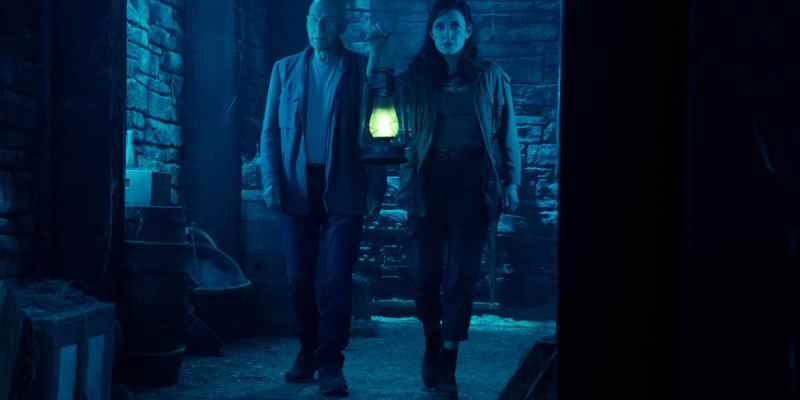This discussion and review contains some spoilers for Star Trek: Picard season 2, episode 9, “Hide and Seek.”
With “Hide and Seek,” Star Trek: Picard brushes up against a problem that has haunted the Star Trek franchise since at least February 1999: the collapse of the Borg Collective as a credible threat.
The Borg were the breakout alien species on Star Trek: The Next Generation. This was cemented with their use in “The Best of Both Worlds,” an episode that both brought the show into its own and was a genuine cultural phenomenon. The Borg have been a focal point for decades of Star Trek media, including video games, theme park experiences, and even the feature film Star Trek: First Contact. It is no surprise that the Borg returned for Picard, despite Patrick Stewart’s reticence.
However, the franchise has often struggled with the Borg. Over the decades, the franchise has found new angles on plenty of existing aliens. Star Trek: Deep Space Nine fleshed the Ferengi out into a complex and multifaceted species. Star Trek: Enterprise found a newish approach to the Klingons in episodes like “Judgment” or the “Affliction” duology. Even the Romulans provided fodder for Deep Space Nine episodes like “In the Pale Moonlight” and “Inter Arma Enim Silent Leges.”
However, the franchise has struggled to adapt and update the Borg as a viable threat, which is ironic for a species defined by their ability to adapt to any threat. It’s tempting to blame Star Trek: Voyager for the collapse of the Borg as a menacing antagonist, but this was arguably evident even towards the end of The Next Generation, where the show’s last season-bridging cliffhanger “Descent” found the Borg effectively serving as heavy muscle for Data’s (Brent Spiner) evil twin Lore (also Spiner).

There have been a handful of standout episodes featuring the Borg since the end of The Next Generation. “Child’s Play” is an underrated episode of Voyager that interrogated the show’s more reactionary tendencies. On Enterprise, “Regeneration” worked largely by stripping the Borg of any meaning and boiling them down to a horror movie threat. For all its problems, even the first season of Star Trek: Picard found an interesting angle on a collapsed Borg community.
Still, the Borg suffered from a unique decline among the major villains of the Star Trek pantheon. There are several reasons for this. The most obvious and superficial is that the Borg largely ended up in the custody of Voyager’s writers’ room, while other recurring aliens remained in the care of the Deep Space Nine creative team. Deep Space Nine was just a much better (and more ambitious) show than Voyager, so it was much better at developing its alien cultures, both old and new.
Perhaps related to this, the Star Trek franchise never seemed to understand what exactly the Borg represented. The Klingons were a handy stand-in for old Cold War enemies. The Romulans were a space-based Roman Empire that served as a mirror to the Federation’s New Frontier utopianism. The Ferengi were grubby little capitalists. The Borg, on the other hand, were a striking visual and design, but a somewhat abstract concept.
Were the Borg Collective a metaphor for the Soviet Union, the fear of the erasure of the individual in the face of communism? If so, they arrived quite late to the party. They first appeared in “Q Who” in May 1989, as the Soviet Union was collapsing. Just two and a half years later, on Christmas Day 1991, Mikhail Gorbachev would announce the end of the Union of Soviet Socialist Republics. Ironically, the Borg were not even at the peak of their popularity to that point.

Many later Star Trek stories would try to build on this metaphor, treating the Borg Collective as analogous to the former Soviet Republics. This was the premise of episodes like “Descent,” “Unity,” “Collective,” and even “Unimatrix Zero.” The Borg Collective seemed to be frequently collapsing into itself, falling apart. The trend even carries over to Picard. The announcement of a revived Borg threat in “The Star Gazer” had a lot of resonance following recent Russian expansionism.
However, the Borg Collective was too important to be allowed to truly collapse into itself, so that allegory never really worked. Ironically, Deep Space Nine would off-handedly home in on a pretty compelling read on the Borg in a throwaway line in “For the Cause,” when Michael Eddington (Kenneth Marshall) suggests that they are a dark mirror to the Federation, and that “assimilation” is not so different from what the Federation wants of its allies and members.
All this circles back around to the central problem facing “Hide and Seek,” the penultimate episode of Star Trek: Picard season 2. This season is incredibly heavy on fan service, populated with elements like the return of Q (John de Lancie), Guinan (Whoopi Goldberg), and the Borg Queen (Annie Wersching), or the casting of Brent Spiner as yet another human relative of Data. The season opened with a massive homage to First Contact, including the return of the Borg.
However, the show has no idea what to do with any of these elements, let alone how they should interact with one another. The idea of the Borg running loose on 21st century Earth is a compelling story hook. Even a single drone trying to either assimilate humanity or trying to establish contact with the Borg Collective would be a compelling threat. What do the Borg mean in the era of the internet? What happens if a tech company gets a hold of Borg technology?

“Hide and Seek” takes the idea of a Borg Queen on modern-day Earth and turns it into an uninspired runaround using generic henchmen with some quick-and-easy makeup applied to their faces. The idea of using firearm laser sights to stand in for the red lights on the side of the drones’ heads is a clever visual, but it is not enough to sustain an entire episode. There is no reason for the “Spearhead” mercenaries in “Hide and Seek” to even be assimilated, except for lazy fan service.
It is all frustratingly generic. It is possible that Stewart is responsible for pushing the show towards its action sensibility, given his famous reported complaint that Picard needed to do more “fucking and fighting,” but it is disappointing to see Star Trek descend to bland goons waving machine guns down dark hallways. “Hide and Seek” even strips the Borg of their iconic cybernetic appearance, perhaps because, to quote showrunner Terry Matalas, a contemporary aesthetic is “less expensive.”
Befitting an episode about the Borg, everything about “Hide and Seek” feels like it takes the path of least resistance. Adam Soong (Spiner) offers a big “not so different” speech to Picard (Stewart) that is decidedly undercooked. “Captains of ships and captains of industry,” he boasts. “To men like us, love and fear, the same thing. Means to an end.” That’s just nonsense. At one point, Seven (Jeri Ryan) earnestly urges Jurati (Alison Pill), “I know you’re in there. I know you can fight.” It’s all cliché.
There is something potentially interesting in Raffi’s (Michelle Hurd) confession to Elnor (Evan Evagora) that she held him back because of her own fear, making her an intriguing mirror to Soong and Kore (Isa Briones), but “Hide and Seek” over-eggs the pudding. “I share the recollection of Elnor’s final breath,” a holographic Elnor reassures Raffi, “enough to know that his last thoughts of you were not of blame, but of love.” How does that make any sense whatsoever?

There is also something potentially interesting in Jurati’s efforts to make peace with the Borg Queen. Enterprise writer Garfield Reeves-Stevens has argued that, at its core, Star Trek is the story of “how our enemies become our friends.” This happened with the Klingons and the Ferengi, so why can’t it happen with the Borg? What would that look like? “What if we take this ship and build a better Borg?” Jurati asks. “A real Collective, built not on assimilation, but salvation?”
However, to make that argument convincingly, “Hide and Seek” would have to understand what the Borg actually are. Jurati ultimately tries to reduce the Borg to some trite pop psychology. “This was never about perfection,” Jurati taunts. She insists that the Borg Queen needed more because of some psychological dependency. “It was never enough because you’re just like me, lonely.” It is reductive and simplistic, reducing an entire culture to an individual character’s psychosis.
Indeed, the episode’s most telling moment is ultimately a small one. Seven is wounded during the big climactic battle. Jurati convinces the Queen to heal and resurrect Seven. The Queen is convinced, but warns that there is “a cost in saving her.” That cost turns out to be… the restoration of Seven’s Borg implants after they were erased in “Penance.” The price is the reset of the status quo, the restoration of Seven of Nine back to factory defaults, to the classic action figure mold.
There’s a hollowness to all this, the sense of watching a shell game in action. There’s no progress, no growth, no development. Nobody ever ends up much further than where they started. There is no sense of what any of this actually means, beyond the idea that the iconography might have some material value divorced from any understanding of it. It feels appropriate that so much of “Hide and Seek” takes place in a decaying and collapsing mansion. It might be the episode’s best metaphor.
